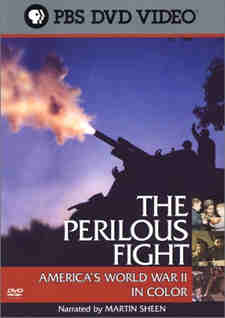|
|


TechnoFILE is copyright and a registered trademark © ® of
Pandemonium Productions.
All rights reserved.
E-mail us Here!

The Perilous Fight on DVDPBS has put together an all-color look at World War II with this 220 minute extravaganza. That’s a unique way of presenting the war, and one gets the impression that they had to take what they got (since most WWII footage was undoubtedly shot in black and white). This might explain the preponderance of shots that include wounded soldiers and medical personnel, along with footage of internment camps and black soldiers in action (or lack of, according to the narration). Or maybe it's PBS' well-known liberal bent... Still, it’s fascinating and at times quite emotional, and the producers have also backed the footage with wartime radio broadcasts, passages from diaries and letters by people who served and those who waited for them. It’s all quite compelling, though as hinted at above PBS has managed to get some liberal spin into the four part miniseries (which shouldn’t come as a surprise). Rather than focusing on the war itself – a noble effort to rid the world of vicious dictators of the ilk removed from office by the Americans, British, and others, in early 2003 – they dwell on the plight of black soldiers, Japanese internees, women, and the fact that some of the bombing took out civilian areas of enemy cities. Interestingly, the producers bemoan the fact that black soldiers weren’t immediately sent to die in battle but were instead given mostly more menial jobs that freed up more white guys to die. Their point may have been that war -and the US - should have been color blind, and maybe it should have been, but isn’t this irrelevant when talking about a different time when circumstances were different? Just give us the facts and spare us the moralizing. We can draw our own conclusions. Ditto the Japanese internees. As with slavery, the internment was a black mark on the US (and Canada, that bastion of liberalism where exactly the same thing happened), but those in charge were dealing with a perceived threat. Whether or not it was a real threat we aren’t competent to say; unlike PBS and other revisionists, we’ll give the people of the time the benefit of the doubt that they were doing what they thought best. Likewise the “carpet bombing.” Smart bombs, which still go astray occasionally, weren’t available back then – and the war had to be won. One of the ways to win a war is to destroy an enemy’s will to fight. This is what happened with Japan, too, whose authorities were prepared to sacrifice untold thousands of their own people – and take untold thousands of Allied soldiers with them - rather than surrender. The atomic bombs undoubtedly saved many lives by ending the war earlier rather than much later. And The Perilous Fight hints at this, but shies away from drawing that particular conclusion. Interesting that they shied from that conclusion when they're so quick to reach other, more politically correct, conclusions. Hindsight is 20/20, as they say. We think it unwise to second guess people who lived before we were born, and tell them how they should have run things in a time that, since we weren’t there and we don’t trust the media to tell us the truth, we aren’t competent to judge. So let’s lighten up and give the so-called "Greatest Generation" the benefit of the doubt. If you ignore the heavy-handed left-leaning aspects this is a very interesting miniseries, with gripping footage that not only shows the horrors of war, but the uplifting aspects of war – the camaraderie between soldiers, the heroism and strength of those who served and those who loved them. It’s a good look into a time in human history in which one generation saved subsequent generations from a life of slavery. And since it’s in color, today’s youth (who seem to eschew black and white productions) might even be encouraged to watch it, and that makes it worthwhile. Too bad they won't get the balance a real documentary (as opposed to a Michael Moore "documentary," for example) is supposed to offer. One thing that’s discouraging, though understandable since the vast majority of the footage was s hot by Americans, is the scarce mention of the other Allies. While the British are acknowledged, there are only a couple of mentions of Canadians and other allies; it’s almost as if the US won the war single-handedly. They surely tipped the balance, and may be been dominant for the last couple of war years, and we wouldn’t think of trying to minimize their valor and contributions, but they were by no means alone. Anyway, the quality of the footage varies, not surprisingly, but overall it’s very good – and very gripping. The DVD is presented in the 4x3 full frame aspect ratio and, while it isn’t 16x9 TV compatible, it’s the way the footage was shot and that makes it fine with us. Picture quality is spotty, not because of the DVD but because of the original footage. Audio is Dolby Digital Surround Stereo and is about what you’d expect from a blend of old footage with new narration and voiceovers: it’s all over the map. But one doesn’t watch a DVD like this for the audio/video quality: it’s the meat that counts. The extras are pretty fine, too. You get excerpts from four original WWII documentaries including some by legendary director John Ford, and it’s all well worth watching. The Perilous Fight, from Warner Home Video
|
|
|
|
|
| Support TechnoFile via Paypal |
| TechnoFILE's
E-letter We're pleased to offer our FREE private, subscription-based private E-mail service. It's the "no brainer" way to keep informed. Our Privacy Policy |